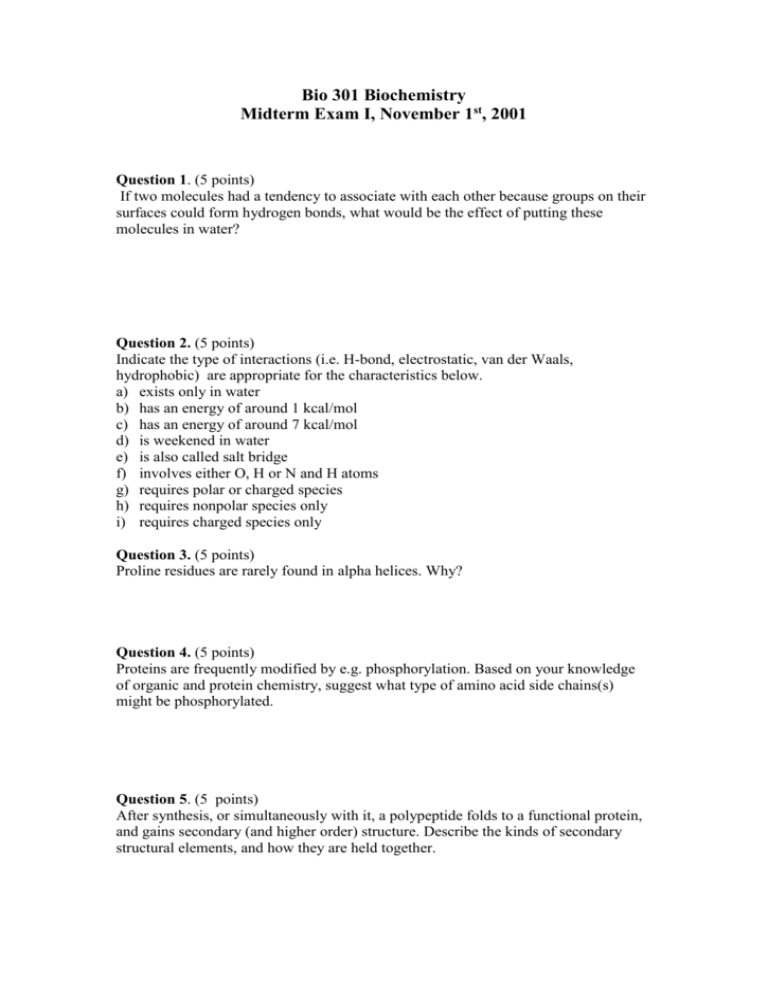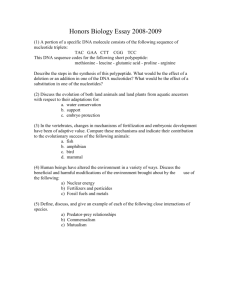BIO-301 Midterm 1 2001
advertisement

Bio 301 Biochemistry Midterm Exam I, November 1st, 2001 Question 1. (5 points) If two molecules had a tendency to associate with each other because groups on their surfaces could form hydrogen bonds, what would be the effect of putting these molecules in water? Question 2. (5 points) Indicate the type of interactions (i.e. H-bond, electrostatic, van der Waals, hydrophobic) are appropriate for the characteristics below. a) exists only in water b) has an energy of around 1 kcal/mol c) has an energy of around 7 kcal/mol d) is weekened in water e) is also called salt bridge f) involves either O, H or N and H atoms g) requires polar or charged species h) requires nonpolar species only i) requires charged species only Question 3. (5 points) Proline residues are rarely found in alpha helices. Why? Question 4. (5 points) Proteins are frequently modified by e.g. phosphorylation. Based on your knowledge of organic and protein chemistry, suggest what type of amino acid side chains(s) might be phosphorylated. Question 5. (5 points) After synthesis, or simultaneously with it, a polypeptide folds to a functional protein, and gains secondary (and higher order) structure. Describe the kinds of secondary structural elements, and how they are held together. Question 6. (15 points) SDS-polyacrylamide gel electroporesis (SDS-PAGE) was used to calculate the molecular weight of proteins X and Y. a) During gel filtration chromatography, protein Y was eluted from the column first and was followed by protein X. Which protein should migrate furthest in the SDSPAGE gel, and why? b) The following proteins were subjected to SDS-PAGE: Protein molecular weight (kDa) migration (mm) Serum albumin 67 11 Ovalbumin 45 23 Carbonic anhydrase 32 34 Lysozyme 14.4 59 Protein X ?? 28 Protein Y ?? 54 Calculate the molecular weights of Proteins X and Y. (use the graph paper provided) c) Suggest the reasons why the results of the gel filtration analysis and SDS-PAGE analysis may not agree. Is there a better way to determine the molecular weight of a protein. Question 7. (10 points) A polypeptide is subjected to the following degradative techniques resulting in polypeptide fragments with the indicated amino acid sequences. Cyanogen bromide treatment: 1. Asp-Ile-Lys-Gln-Met 2. Lys 3. Lys-Phe-Ala-Met 4. Tyr-Arg-Gly-Met a) Trypsin hydrolysis: 5. Gln-Met-Lys 6. Phe-Ala-Met-Lys 7. Tyr-Arg What is the amino acid sequence of the entire polypeptide? Question 8. (5 points) Compare the advantages and disadvantages of x-ray crystalography and NMR techniques in determining atomic structures of macromolecules. Question 9. (5 points) The sedimentation velocity of a protein in a centrifuge does not depend on the a) density of the solution b) density of the protein c) charge on the protein d) shape of the protein e) mass of the protein Question 10. (5 points) Which phosphate group (alpha, beta, or gamma phosphate group) in dNTP’s would you use for radioactive labelling of a DNA molecule in vitro? Question 11. (5 points) Match the characteristics of A-, B- or Z-DNA structures: a) … has a relatively wide and deep major groove. b) … has a structure similar to that of double-stranded RNA. c) … is favoured for dehydrated DNA. d) … forms for DNA-RNA hybrids. e) phosphate backbone are neither right handed nor left handed in ……. Question 12. (5 points) Which of the following statements about topoisomerases are correct? a) They alter the linking numbers of topoisomers, b) They break and re-seal disulfide bonds. c) They form covalent intermediates with their DNA substrates. d) They can (in the ces of a particular topoisomerase), use ATP to form negatively supercoiled DNA from relaxed DNA in E. coli. Question 13. (5 points). Suppose that a single-stranded circular DNA with the base composion of 20%A, 30%T, 15%C and 35%G serves as the template for the synthesis of a complementary strand by DNA polymerase. a) Give the base composition of the complementary strand. b) Give the overall base composition of the resulting double helical DNA. Question 14. (5 points) Which of the following nucleotide substitutions are transversion mutations? a) G for A b) A for C c) C for T d) T for G Question 15. (5 points) Which of the following statemeints about DNA replication in E. coli are correct? a) It occurs at a replication fork b) The origin of replication is rich in A-T content c) It proceeds with one replication fork per replicating molecule d) It involves discontinuous spnthesis of the leading strand e) It uses RNA transiently as a template Question 16. (10 points) a) DNA polymerase I performs three different activities. What are they? b) DNA polymerase I needs a free 3’-OH group to be able to initiate. What consequences does this have?





